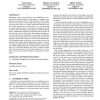Free Online Productivity Tools
i2Speak
i2Symbol
i2OCR
iTex2Img
iWeb2Print
iWeb2Shot
i2Type
iPdf2Split
iPdf2Merge
i2Bopomofo
i2Arabic
i2Style
i2Image
i2PDF
iLatex2Rtf
Sci2ools
ATAL
2015
Springer
2015
Springer
Robust Strategy against Unknown Risk-averse Attackers in Security Games
Stackelberg security games (SSGs) are now established as a powerful tool in security domains. In this paper, we consider a new dimension of security games: the risk preferences of the attacker. Previous work assumes a risk-neutral attacker that maximizes his expected reward. However, extensive studies show that the attackers in some domains are in fact risk-averse, e.g., terrorist groups in counter-terrorism domains. The failure to incorporate the risk aversion in SSG models may lead the defender to suffer significant losses. Additionally, defenders are uncertain about the degree of attacker’s risk aversion. Motivated by this challenge this paper provides the following five contributions: (i) we propose a novel model for security games against risk-averse attackers with uncertainty in the degree of their risk aversion; (ii) we develop an intuitive MIBLP formulation based on previous security games research, but find that it finds locally optimal solutions and is unable to scale ...
| Added | 16 Apr 2016 |
| Updated | 16 Apr 2016 |
| Type | Journal |
| Year | 2015 |
| Where | ATAL |
| Authors | Yundi Qian, William B. Haskell, Milind Tambe |
Comments (0)

